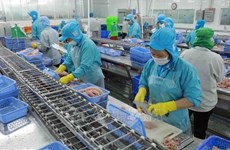S&P raises Vietnam’s credit rating with stable outlook
Standard and Poor’s (S&P) Global Ratings’ recent upgrade of its long-term sovereign credit rating for Vietnam, the first time since 2010, was expected to help the country to attract more foreign investments into the economy and expand exports.
 Tra fish processed for export at Cuu Long An Giang Seafood Import - Export Company in An Giang Province. (Photo: VNA)
Tra fish processed for export at Cuu Long An Giang Seafood Import - Export Company in An Giang Province. (Photo: VNA)Hanoi (VNS/VNA) - Standard and Poor’s (S&P) Global Ratings’ recent upgrade of its long-term sovereign credit rating for Vietnam, the first time since 2010, was expected to help the country to attract more foreign investments into the economy and expand exports.
Late last week, S&P raised its long-term sovereign credit rating for Vietnam to “BB” from “BB-”.
“The stable outlook reflects out expectation that Vietnam’s economy will continue to expand rapidly, exemplifying gradual improvements in its policy-making setting and underpinning credit metrics,” S&P wrote in a press release.
This was the first upgrade since December 2010. The upgrade reflected continued improvements in the Government’s institutional settings, which S&P believed were supporting consistently strong economic growth and development. Vietnam’s broadly balanced external accounts, strong foreign direct investment inflow and a manageable external debt burden provided further supported to the rating, it said.
S&P said the Vietnamese economy had achieved impressive development including consistently high GDP growth.
“Importantly, the Vietnamese government has delivered strong development outcomes since the global financial crisis and its own domestic banking sector crisis at the beginning of this decade,” the credit rating agency said.
“We believe the government's accession as a founding signatory to the Comprehensive and Progressive Agreement to Trans-Pacific Partnership (CPTPP) in late 2018 reflects the government's willingness to adopt and implement necessary reforms, especially in the state sector, over the long term.”
Although Vietnam had a lower middle-income economy, with GDP per capita projected at approximately 2,695 USD in 2019, the economy was relatively diversified.
“Continued improvements in macroeconomic stability have supported a strong performance in large foreign-owned and export-focused manufacturing sectors (electronics, mobile phones, and textiles). The robust FDI-oriented economy is fuelling stronger domestic activity, particularly through the private consumption channel.”
Vietnam's per capita income increased to an estimated 2,572 USD in 2018 from approximately 1,754 USD in 2012.
According to S&P, strong FDI in manufacturing continued in 2018 despite a more challenging external environment, reflecting the resilience of Vietnam's investment environment.
“The country's competitive unit labour costs, improving educational standards and constructive demographics implied continued growth in FDI and goods exports,” the rating agency said, adding that participation in free trade agreements, including the recently established CPTPP, could provide a further upside to Vietnam's export earnings.
The country still faced a variety of domestic and external risks, such as trade disputes, elevated fiscal deficits and public debt, and q relatively weak banking sector, S&P pointed out.
Senior economist from the Bank for Investment and Development of Vietnam Can Van Luc said that S&P’s upgrade on Vietnam reflected the country’s stable macroeconomy, improved fiscal policy and better business climate.
The upgrade would help consolidate confidence among investors and attract more foreign investment inflow, Luc said, adding that there was still room for improvement.
Luc said the country needed to speed up its restructuring process and increase the economy’s resilience to external shocks by resolving bad debt, improving fiscal policy and increasing foreign currency reserves.
In August 2018, credit rating agency Moody’s Investors Service has also upgraded Vietnam’s long-term issuer and senior unsecured ratings to Ba3 from B1 and changed the outlook to stable from positive.
Fitch Rating in May 2018 upgraded Vietnam’s long-term foreign-currency issuer default rating to BB from BB- with a stable outlook.-VNS/VNA












